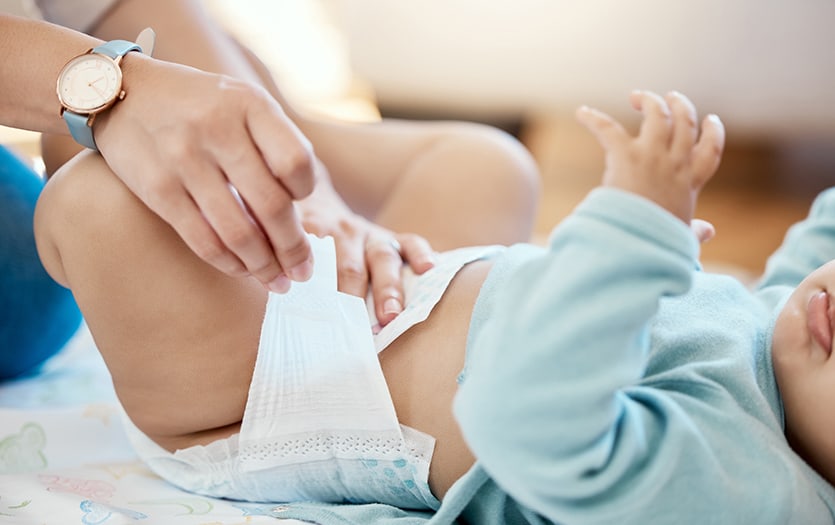Formula is a popular choice for many parents who are unable or choose not to breastfeed their infants. While it provides necessary nutrients for a baby’s growth and development, it can also lead to diaper rash.
Diaper rash is a common condition that affects many infants, causing redness, irritation, and discomfort in the diaper area.
Understanding the causes of diaper rash is important in order to prevent and treat it. While there are many factors that can contribute to diaper rash, including moisture, friction, and contact with irritants, the type of formula used can also play a role.
Certain ingredients in formula, such as lactose or soy, may cause an allergic reaction in some babies, leading to diaper rash.
Key Takeaways
- Formula can cause diaper rash in some babies due to an allergic reaction to certain ingredients.
- Understanding the causes of diaper rash is important in order to prevent and treat it.
- If diaper rash persists or is accompanied by other symptoms, it may be necessary to seek medical attention.
Understanding Diaper Rash
Diaper rash is a common skin condition that affects babies. It is characterized by redness, discomfort, and sometimes sores on the tender skin in the diaper area. The rash can be caused by a variety of factors, including prolonged exposure to wetness, friction, and irritants in the diaper.
Symptoms of diaper rash may include redness, swelling, and tenderness in the diaper area. The rash may also be accompanied by small bumps or pimples, and in severe cases, blisters or open sores may develop.
There are several skin conditions that can mimic the symptoms of diaper rash, including eczema, psoriasis, and fungal infections. It is important to consult a healthcare provider if the rash persists or is accompanied by fever, lethargy, or other symptoms.
Preventing diaper rash involves keeping the diaper area clean and dry, changing diapers frequently, and using gentle products that do not contain harsh chemicals or fragrances. In some cases, a barrier cream may be recommended to protect the skin from moisture and irritation.
If diaper rash does occur, treatment may involve applying a diaper rash cream or ointment to the affected area. In severe cases, a healthcare provider may prescribe a topical or oral medication to help clear up the rash.
Overall, understanding the causes and symptoms of diaper rash can help parents and caregivers take steps to prevent and treat this common skin condition in babies.
Causes of Diaper Rash
Diaper rash is a common condition that affects many infants and toddlers. There are several factors that can contribute to the development of diaper rash. In this section, we will discuss some of the most common causes of diaper rash.
1. Role of Formula
Formula can be a contributing factor to diaper rash. Some infants may be sensitive to certain ingredients in formula, such as milk protein or lactose. This can lead to an allergic reaction or intolerance, which can cause diaper rash.
Additionally, formula can cause changes in the composition of stool, which can lead to irritation and chafing.
2. Irritation and Chafing
Irritation and chafing can also contribute to diaper rash. Wet diapers, soiled diapers, and dirty diapers can all cause irritation and chafing, especially if they are left on for extended periods of time.
Additionally, certain types of fabrics or materials used in diapers can also cause irritation and chafing.
3. Yeast Infections
Yeast infections are another common cause of diaper rash. Yeast thrives in warm, moist environments, which can be created by wet or soiled diapers. Infants who are taking antibiotics are also more susceptible to yeast infections.
4. Bacterial Infections
Bacterial infections can also cause diaper rash. Infants who have frequent bowel movements or diarrhea are more susceptible to bacterial infections. Additionally, certain types of bacteria, such as Staphylococcus aureus, can cause diaper rash.
5. Allergic Reactions
Allergic reactions can also contribute to diaper rash. Infants who have allergies or sensitivities to certain foods or materials may develop diaper rash as a result. Additionally, some infants may develop hives or other allergic reactions in response to certain irritants.
In conclusion, there are several factors that can contribute to the development of diaper rash. Parents can take steps to prevent diaper rash by changing wet or soiled diapers promptly, using gentle and fragrance-free wipes, and avoiding harsh chemicals or materials that can cause irritation.
If diaper rash does develop, it is important to seek medical attention to determine the underlying cause and appropriate treatment.
Diagnosis of Diaper Rash
Diaper rash is a common skin condition that affects babies. It is characterized by redness, sores, and discomfort in the diaper area. While diaper rash can be caused by a variety of factors, including irritation from urine and feces, it is important to have it diagnosed by a doctor or pediatrician to rule out any underlying medical conditions.
When diagnosing diaper rash, doctors and pediatricians will typically examine the affected area and ask about the baby’s symptoms. They may also ask about the baby’s diet and hygiene practices to determine if any changes need to be made. In some cases, a skin culture may be taken to rule out a bacterial or fungal infection.
The most common symptom of diaper rash is redness and irritation in the diaper area. The skin may also be tender to the touch and may develop small sores or bumps. In severe cases, the skin may become raw and bleed. If a baby is experiencing discomfort or pain, it is important to seek medical attention right away.
To prevent diaper rash, it is important to change a baby’s diaper frequently and to keep the diaper area clean and dry. Using a barrier cream or ointment can also help to protect the skin and prevent irritation. If diaper rash does occur, it is important to treat it promptly to prevent further discomfort and to promote healing.
In conclusion, while diaper rash is a common condition that affects babies, it is important to have it diagnosed by a doctor or pediatrician to rule out any underlying medical conditions. By taking steps to prevent diaper rash and seeking prompt medical attention when it does occur, parents can help to keep their babies comfortable and healthy.
Treatment Options for Diaper Rash
When it comes to treating diaper rash, there are a variety of options available. The following are some of the most common treatments:
1. Over-the-Counter Treatments
Over-the-counter treatments are often the first line of defense against diaper rash. These treatments are widely available and can be purchased at most drugstores and supermarkets. Some common over-the-counter treatments include:
- Diaper rash cream: This cream is designed specifically to treat diaper rash. It typically contains zinc oxide, which helps to soothe and protect the skin.
- Antifungal cream: If the diaper rash is caused by a fungal infection, an antifungal cream may be necessary. These creams are designed to kill the fungus and relieve the symptoms of the rash.
- Zinc oxide ointment: Similar to diaper rash cream, zinc oxide ointment can help to soothe and protect the skin.
2. Prescription Treatments
If over-the-counter treatments are not effective, a doctor may prescribe a stronger medication. Some common prescription treatments for diaper rash include:
- Prescription-strength diaper rash cream: This cream is similar to over-the-counter diaper rash cream, but contains a higher concentration of active ingredients.
- Antifungal medication: If the diaper rash is caused by a fungal infection, an oral antifungal medication may be necessary.
3. Home Remedies
In addition to over-the-counter and prescription treatments, there are also a variety of home remedies that may help to soothe and heal diaper rash. Some common home remedies include:
- Witch hazel: This natural astringent can help to soothe irritated skin.
- Aloe vera: Aloe vera gel can help to moisturize and soothe the skin.
- Calendula: This natural anti-inflammatory can help to reduce redness and inflammation.
- Shampoo clay: This natural clay can help to soothe and heal irritated skin.
Preventing Diaper Rash
1. Diapering Practices
Preventing diaper rash starts with good diapering practices. Here are some tips to keep in mind:
- Change your baby’s diaper frequently, at least every two to three hours.
- Clean your baby’s diaper area thoroughly with mild soap and water during each diaper change.
- Avoid using wipes that contain alcohol or fragrances, which can irritate your baby’s skin. Instead, use plain water or a mild wipe.
- Let your baby’s skin air dry for a few minutes before putting on a fresh diaper.
- Avoid using tight-fitting diapers or clothing that can trap moisture against your baby’s skin.
2. Dietary Considerations
Your baby’s diet can also play a role in preventing diaper rash. Here are some things to keep in mind:
- Breastfeeding can help prevent diaper rash because breast milk contains antibodies that can help fight off infection.
- If your baby has started solid foods, introduce them slowly and watch for any signs of food allergy or sensitivity.
- If your baby has diarrhea, be sure to change their diaper frequently and clean their diaper area thoroughly to prevent irritation.
- Be sure to offer your baby plenty of fluids to help prevent constipation, which can lead to harder stools that are more difficult to pass.
By following these tips, you can help prevent diaper rash and keep your baby’s skin healthy and comfortable.
When to Seek Medical Attention
If a baby’s diaper rash does not improve within a few days of using over-the-counter remedies, it may be time to seek medical attention. Additionally, if the rash is severe, causing discomfort or pain, or accompanied by other symptoms, medical attention should be sought immediately.
Pediatricians or doctors may recommend prescription-strength creams or ointments to treat the rash, or they may need to investigate if there is an underlying infection or allergic reaction. If a baby is crying excessively or showing signs of distress, it is essential to seek medical attention to rule out any serious conditions.
In some cases, diaper rash can be a sign of a more severe allergic reaction or anaphylaxis. If a baby shows signs of difficulty breathing, swelling, or hives, seek emergency medical attention immediately.
It is essential to keep an eye on the rash and monitor any changes or worsening symptoms. If a baby’s diaper rash does not improve or gets worse despite treatment, it may be a sign of a more serious condition that requires medical attention.
Additional Resources
For more information on diaper rash and the potential causes, there are a variety of resources available to parents and caregivers.
One helpful resource is the Cleveland Clinic, a non-profit academic medical center that provides a wide range of information on child health and wellness. Their website offers an overview of diaper rash, including symptoms, causes, and treatment options.
Additionally, they provide tips for preventing diaper rash, such as changing diapers frequently and using gentle, fragrance-free products.
Another useful resource is the American Academy of Pediatrics (AAP), a professional organization dedicated to promoting the health and well-being of children. Their website includes a section on diaper rash, which covers common causes and treatment options.
They also offer guidance on choosing the right diapers and wipes, as well as tips for preventing diaper rash from occurring in the first place.
Finally, parents and caregivers may find it helpful to speak with their child’s pediatrician or healthcare provider. These professionals can provide personalized advice and guidance, as well as recommend products and treatments that may be most effective for their child’s specific needs.
Overall, by utilizing these additional resources, parents and caregivers can gain a better understanding of diaper rash and how to prevent and treat it effectively.
Related posts:
Frequently Asked Questions
Can changing formula cause diarrhea?
Yes, changing a baby’s formula can cause diarrhea. This is because the baby’s digestive system needs time to adjust to the new formula. However, if the diarrhea persists for more than a few days, it is important to consult a doctor.
What causes diaper rash?
Diaper rash is usually caused by prolonged exposure to wetness, friction, and irritants in the diaper area. These irritants can include urine, feces, and chemicals in diapers or wipes. Bacterial or fungal infections can also cause diaper rash.
Can milk cause diaper rash in toddlers?
Yes, milk can cause diaper rash in toddlers. The lactose in milk can cause irritation and inflammation in the diaper area. If your toddler is experiencing diaper rash, it may be helpful to switch to a non-dairy milk alternative.
Can soy formula cause diaper rash?
Yes, soy formula can cause diaper rash. Soy contains phytoestrogens, which can cause a reaction in some babies. If your baby is experiencing diaper rash while on soy formula, it may be helpful to switch to a different type of formula.
What does an allergic reaction diaper rash look like?
An allergic reaction diaper rash can look like red, raised bumps or hives in the diaper area. The rash may be itchy and uncomfortable for the baby. If you suspect your baby is having an allergic reaction, it is important to consult a doctor.
Why does my baby keep getting a diaper rash?
There are several reasons why a baby may keep getting diaper rash. Some common causes include not changing the diaper frequently enough, using diapers or wipes with harsh chemicals, and not allowing the baby’s skin to fully dry before putting on a new diaper.
It is important to identify the cause of the diaper rash and take steps to prevent it from recurring.

Iesha is a loving mother of 2 beautiful children. She’s an active parent who enjoys indoor and outdoor adventures with her family. Her mission is to share practical and realistic parenting advice to help the parenting community becoming stronger.



